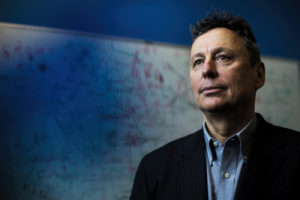Before he studied cracks, Northeastern physics professor Alain Karma studied snowflakes. He was struck by their patterning, how their intricate, crystalline branches emerged from a world of equilibrium.
Somewhere along the way, he realized that cracks aren’t so different: They, too, form complex, mysterious, beautiful branches as they carve out their paths.

Alain Karma, director of the Center for Interdisciplinary Research on Complex Systems at Northeastern University. Photo by Adam Glanzman/Northeastern University
At first, Karma simply wanted to understand their patterns, to unravel the secrets of their movements. Then, he became fascinated by their many applications.
For starters, says Karma, understanding how cracks form could be the key to developing longer-lasting cellphone batteries. “Your cellphone always runs out of battery,” he says. “You have to always charge it, right? And that’s because cellphone batteries use conventional graphite electrodes.”
When we charge our devices, lithium ions flow from the battery’s positive electrode (the cathode) to the negative electrode (the anode). As the battery drains, lithium moves in the opposite direction, flowing away from the anode.
Therefore, a device’s battery life depends upon how much lithium can be stored in that anode—and the graphite anodes in our batteries are pretty subpar at lithium storage.
On the flipside, anodes made from silicon have about 10 times the charging capacity. But there’s a catch: While silicon is great at storing lithium, it cracks under stress.
When lithium enters silicon, the silicon swells in volume by 300 percent, much like a dry sponge expands after absorbing water. Then it shrinks again. This repeated swelling and shrinking strains the material, causing the anode to crack.
Luckily, Karma has some leads. He’s currently working to design silicon anodes of different shapes to develop a structure that can withstand swelling without cracking, thereby increasing the charge capacity of cellphone batteries everywhere.
And this past April, he received a grant from the National Science Foundation to continue studying the fundamentals of crack movements. Theoretically, he explains, when cracks move along a surface, they should be able to reach the speed of sound. In practice, however, this doesn’t happen, because cracks become unstable as they speed up, wobbling from side to side.
Along thin, almost-two-dimensional plates similar to a sheet of paper, they can reach more than 90 percent of this maximum speed. But in thicker, three-dimensional materials—imagine, say, a block of cheese—cracks become unstable at much lower velocities, and the main crack splinters into tiny offshoots called microbranches.
“That’s exactly what we’re trying to understand: how the crack forms and becomes unstable in three dimensions,” Karma says. “We’re trying to crack the mystery of how this microbranching instability occurs.”
That research could someday lead to stronger materials, and that’s exactly what he’s trying to develop in a study with Northeastern engineering professors Sandra Shefelbine and Randall Erb. They’re examining a material that has long fascinated researchers in his discipline: bone.
Bone, Karma explains, is a composite material made out of relatively soft collagen fibers and hard crystals. Together, these substances make it more resistant to cracks.
Inspired by this natural feat, Karma and his colleagues are developing and analyzing a synthetic substance that mimics bone’s toughness: hard aluminum platelets embedded into a soft polymer.
They’re aiming to develop a high-strength engineering material, but Karma says their work could have medical implications as well. As people age, he says, the crystals interspersed in their collagen often become disorganized, leading to the bone-softening condition osteoporosis.
“These insights that we’re getting could be useful to understand how bone can become brittle and break under pathological conditions,” he says.
Someday, Karma’s research could lead to incredible innovations: Better batteries. Tougher materials. A stronger understanding of the aging human body. But even beyond these breakthroughs, his work reminds us to search for wonder in unusual places—to notice elegance and potential within the cracks.
Beneath Karma’s careful analyses and complex computations, we discover a simple, enduring truth: Even in brokenness, there is beauty to be found.
This story was originally published on News @ Northeastern on July 2, 2019.

